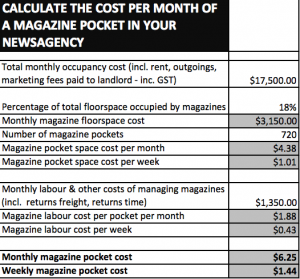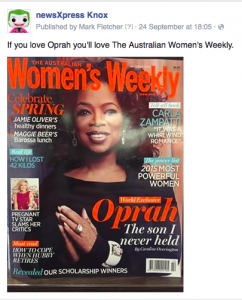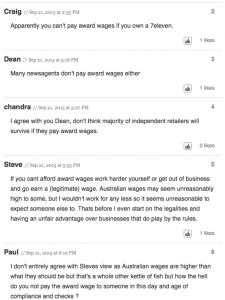 With magazine cover prices not keeping up and no movement in newsagent margin percentage, the only option is to cut the cost of carrying magazines. While most newsagents have cut labour costs by using newsagency software to manage sales and returns, many are yet to manage the retail space.
With magazine cover prices not keeping up and no movement in newsagent margin percentage, the only option is to cut the cost of carrying magazines. While most newsagents have cut labour costs by using newsagency software to manage sales and returns, many are yet to manage the retail space.
I created a spreadsheet space cost calculator. This is the first step to managing magazine space for profit: understand your weekly magazine pocket cost. It could be that your cost is small, making magazines profitable.
In most newsagencies, however, the high cost of retail space and the high cost of labour will mean a high per pocket cost. Pocket costs are exacerbated by systematic and planned gross oversupply of stock to newsagents.
The best way to cut the overhead costs associated with magazines is to reduce the space allocated. This does not mean cutting magazines, or at least not cutting as many magazines as you may think. No, it is all about reducing the amount of space allocated to magazines.
Here are the steps I recommend newsagents take. They are steps I have followed for years in my own newsagencies. They are steps I have recommended to others with success.
- Relay your magazines. Get the right layout for your business. This is the appropriate next step as the work itself reacquaints you with what you sell. Click here for my updated advice on how to do a magazine relay.
- Reduce space used. In some title categories of your magazine department you will be able to fit more than one magazine per pocket. You may fit three magazine titles into two pockets or five titles into three. Every pocket saved is space you could use for something else. Here are examples of categories where I have seen this work:
- Woodworking.
- Model trains.
- Trains / planes / boats.
- Special interest auto.
- Special interest sport.
- Special interest music.
- British weekly.
- British monthly.
- Fringe fashion.
- Intellectual.
- Decide how many magazine pockets you will cut. Do this by running a Magazine Sell Through rates report. Titles with a sell through of less than 40% ought to be up for consideration to be cut. You decide your cutoff point based on your business needs. Be thoughtful in your process. Do not approach this task with anger.
- Decide other changes for magazines. The report you produce in the above step will also show top selling magazine titles. Use this data to chase a sales increase. Leverage the positive information for your commercial advantage.
- Do not try and do everything at once. Expect to cut space several times. For example, if you have 1,200 pockets today and you have 500 titles with a sell through of 40% or less, cut 300 pockets in your first go. Do this, measure over several months, plan then consider doing it again.
- Advise the magazine distributors. Write to each distributor on your business letterhead advising them you have cut magazine pockets by xxx. Be specific on the number of pockets and the percentage of space cut – this is important. Advise that the change has been made. Ask they immediately cut the number of titles by the same percentage as your cut. Ask for them to acknowledge the letter. Fax the letter and post in an Express Post envelope – keep the tracking number of the envelope.
- Watch your supply. If, after three weeks, there is no reduction, send another letter with a copy of your earlier letter.
- Watch your supply II. If, after a further three weeks there is no reduction, act by making a complaint to your local Small Business Commissioner. Request mediation. Explain the steps you have taken and why you have taken. Ask for their intervention.
- Consider legal action. Consider using VCAT, QCAT or a similar state based tribunal to have your complaint adjudicated. This action will force mediation. Note: it is at this point that most newsagents will give up, preferring to complain than following a process to the end. Taking the matter to a tribunal is vital if you want to demonstrate you are serious in your endeavour.
- Use the new space. There is no point in cutting unprofitable magazine space unless you have a plan to use it for something else. You should not start work on the list I have documented here unless you have a valuable use for the space you will free in your business.
Despite what the magazine distributors might say, you have control over the magazine space you pay for. The process outlined here, while time consuming, provides the distributors with a visibility of data about your business on which they must act if they are ethical in how they run their business.
I urge you to give them the benefit of the doubt embedded in these processes. I am confident that if you follow the processes I have outlined you will achieve reduction. It may take some extra steps or duo ling of work – but it will work.
Keep your communication civil. Be clear that you do not want to quit magazines altogether. Outline your cost base and that unless the change you seek is brought about your business is under broader pressure on its very survival.
Magazines are important in any newsagency. The million dollar question is how many magazines? I think that number is currently somewhere between 600 and 700 titles. I am confident this figure is understood by key people in magazine publishing and distribution. Thanks to the work outlined here you can fit 700 titles today in the space you would have used for 1,000 titles previously.
The difficulty right now is that we newsagents are agitating for more efficient supply while magazine distributors are operating with some publisher contracts that hark back to a time when there was less pressure on the issue of oversupply.
There is no shortcut to this process, no way to avoid the work of the steps above. Sure, there is a time commitment. It is your business. You need to invest in its future. Complaining about having no time takes time away from getting the work done. get on with it – pursue the one goal of achieving a lower overhead cost for magazines in your business.
What do you think? Let me know. Also, let me know if you need help.
To publishers: if you read this and worry about your title, my advice is only worry if your title is supplied at a volume that makes it unprofitable for newsagents. The equation is simple really – oversupply and your title is more likely to be cut … as it should be.
To the ANF: Where are you in all this? Lost at sea, preferring to hop behind publishers and distributors without offering critical analysis and professional thought to practical steps newsagents can take.














